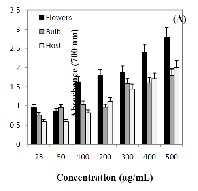Antioxidant capacity and total phenols richness of Cistanche violacea hosting Zygophyllum album
Keywords:
Cistanche violacea, Zygophyllum album, ferric reducing power, metal chelating activityAbstract
Cistanche violacea is an Orobanchaceae holoparsite hosting chenopodiaceous, including Zygophyllum album. While Cistanche violacea, is known to have edible uses in the folk medicine, no data have been reported before. In the present study, chemical assays were undertaken in order to emphasize the Cistanche violacea antioxidant capacity and total phenols richness. Our data showed higher phenolic contents were measured in Cistanche flowers and Zygophyllum leaves, however Cistanche bulb was the most enriched in flavonoïds. Antioxidant activities were evaluated in methanolic extract of Cistanche violacea flowers and bulb among the host Zygophyllum album leaves. Cistanche flowers and Zygophyllum leaves exhibited the strongest scavenging 2,2-diphenyl-2-picrylhydrazyl radical (DPPH) activity. The metal chelating activity was the highest in Cistanche bulb and Zygophyllum leaves compared to Cistanche flowers. Conversely, the ferric reducing power was significantly higher in Cistanche flowers relative to its bulb and Zygophyllum leaves
References
. Dong Q, Jao J, Fan JN, Ding K.
Structural characterization and
immunological activity of two coldwater extractable polysaccharides
from Cistanche deserticola Y.C. Ma.
Carbohydrates Research. 2007,
: 1343-1349.
. Yamada P, Iijima R, Han J,
Shigemori H, Yokota S, Isoda H.
Inhibitory effect of acteoside isolated
from Cistanche tubulosa on
chemical mediator release and
inflammatory cytokine production by
RBL-2H3 and KU812 cells. Planta
Med. 2010, 76(14):1512-1518.
. Sato E. Aoyagi Y. & Sugahara, T.
Contents of free aminoacids
in mushrooms. Nippon Shokuhin
Kogyo Gakkaishi. 32: 509-521.
. Lu Ming-Chin. 1998. Studies on the
sedative effect of Cistanche
deserticola. Journal of
Ethnopharmacology. 59(3): 161-
. Heimler D, Vignolini P, Dini M,
Vincieri F, Romani A. Antiradical
activity and polyphenol composition
of local Brassicaceae edible
varieties. Food Chemistry. 2006, 99:
-469.
. Dewanto VX, Wu K, Adom K, Liu DH.
Thermal processing enhances the
nutritional value of tomatoes by
increasing total antioxidant activity.
Journal of Agricultural and Food
Chemistry. 2002, 50: 3010- 3014.
. Brand-Williams W, Cuvelier M, Berset
C. Use of a free radical method to
evaluate antioxidant activity.
Lebensmittel Wissenschaft undTechnologie. 1995, 28: 25-30.
. Zhao F, Yang J, Schoneich C.
Effects of polyaminocarboxylate
metal chelators on iron-thiolate
induced oxidation of methionineand histidine-containing peptides.
Pharmaceutical Research. 1996, 13:
-938.
. Yildirim A, Mavi A, Kara A.
Determination of antioxidant and
antimicrobial activities of Rumex
crispus L. extracts. Journal of
Agricultural and Food Chemistry.
, 49: 4083-4089.
. Sherwin ER. Oxidation and
antioxidants in fat and oil
processing. J. Am. Oil Chem. Soc.
, 55: 809-14.
. Galvez M, Martin-Cordero C,
Houghton PJ, Ayuso MJ. Antioxidant
activity of methanol extracts
obtained from Plantago species. J.
Agric. Food Chem. 2005, 53: 1927-
. Melo EA, Filho JM, Guerra NB.
Characterization of antioxidant
compounds in aqueous coriander
extract (Coriander sativum L.).
LebensmWiss. Technol. 2005, 38:
-19.
. Hou WC, Lin RD, Cheng KT, Hung
YT, Cho CH, Chen CH, Hwang SY,
Lee MH. Free radical scavenging
activity of Taiwanese native plants.
Phytomedicine. 2003, 10: 170-175.
. Sroka Z, Cisowski W. Hydrogen
peroxide scavenging, antioxidant
and anti-radical activity of some
phenolic acids. Food and Chemical
Toxicology. 2003, 41: 753-758.
. Williams RJ, Spencer JPE, RiceEvans C. Flavonoïds: Antioxidants
or signalling molecules? Free
Radical Biology & Medicine. 2004,
(7): 838-849.
. Rice-Evans C. Flavonoïds
antioxidants. Curr. Med. Chem.
, 8: 797-807.
. Liu Q, Xie F, Rolston R, Moreira P,
Nunomura A, Zhu X. Prevention and
treatment of Alzheimer disease and
aging: antioxidants. Mini Rev. Med.
Chem. 2007, 17: 171-80.
. Wong SP, Leong LP, William KJH.
Antioxidant activities of aqueous
extracts of selected plants. Food
Chemistry. 2006, 99: 775-783.
. Heim KE, Tagliaferro AR, Bobilya
DJ. Flavonoïds antioxidants:
chemistry, metabolism and
structure–activity relationships.
Journal of Nutritional Biochemistry.
, 13: 572-584.
. Meir S, Kanner J, Akiri B.
Determination and involvement of
aqueous reducing compounds in
oxidative defense systems of
various senescing leaves. J. Agric.
Food Chem. 1995, 43: 1813-5.
. Joyeux M, Lobstein A, Anton R,
Mortier F. Comparative
antilipoperoxidant, antinecrotic and
scavenging properties of terpenes
and biflawones from Ginkgo and
some flavonoïds. Planta Medica.
, 61: 126-129



